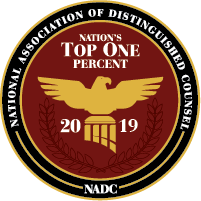It is typically not a good idea to bring alcohol, controlled substances, or questionable contraband into any federal, state, county, or city jail or prison. Not only is it frowned upon, but bringing such items onto penal grounds could result in felony consequences. A felony on your criminal record could negatively impact your future employment and housing opportunities.
Facing charges for bringing alcohol or related substances into a penal institution should not be taken lightly. If you are being charged with such an offense, it is highly recommended you find a criminal defense lawyer who can help.
To gain a critical understanding of what it means to bring alcohol into a penal institution, take a look at how California defines it.
Free Consultation (619) 233-4433
Defining Bringing Alcohol Into Penal Institution
California defines bringing alcohol into a penal institution under Business and Professions Code 25603. This statute states it is a crime for an individual to bring any type of alcoholic drink or beverage into a penal institution or on related grounds. For a more detailed understanding of what it means to violate BP 25603 take a look at the three main facts.
Are prisoners the only culprits that can be guilty of violating this law?
Any person can be guilty of bringing alcohol into a penal institution. It does not matter whether they are a criminal, guard, acquaintance, friend, or family member of a jailee or jailer.
What is considered an alcoholic beverage?
Drinks covered under this law include any type of alcoholic beverage, regardless of how low the alcohol percentage is. Beverages that are prohibited from bringing onto penal grounds include beer, hard liquor, wine, seltzer beers, mixed alcoholic drinks, or any type of homebrewed beer or liquor.
What are the types of penal institutions covered under BP 25603?
A penal institution includes any state, city, or county prison, jail, or reformatory. The grounds of each also include the entirety of the property. This means a person is prohibited from consuming alcohol in the parking lot, just outside the entrance, or within any of the buildings.
Regardless of who you are, if you were caught consuming an alleged alcoholic beverage while on penal grounds contact a defense attorney as soon as you can. The right defense lawyer can effectively challenge these offenses to reduce the charges or potentially get them dropped.
Even if you did not know that bringing alcohol into a penal institution was against the law, you could still face charges. Being aware of this statute is not a necessary factor in determining a person’s guilt.
Associated Offenses
The following offenses are oftentimes charged in association with BP 25603.
California Penal Code 4573 – Bringing drugs into a jail or prison;
This law prohibits knowingly bringing controlled substances, such as illicit drugs, into city or county jail or state prison.
California Penal Code 4573.5 – Bringing contraband into a jail or prison;
This law is violated when you bring items that are considered contraband, such as drugs and/or alcohol, into a city or county jail or state prison.
Closely Related Offenses
California Penal Code 4550 – Rescuing a prisoner;
You violate this law when you attempt or help to rescue a prisoner of the state, otherwise known as attempting or helping with jailbreak or prison escape.
California Penal Code 25608 – Bringing alcohol into a public school building or educational facility;
You commit this crime when you bring alcohol into a public education facility or on school grounds, including public grade schools, colleges, or universities.
California Health and Safety Code 11350 – Possession of a controlled substance;
This law prohibits the unlawful simple possession or illegal possession for ‘personal use’ of a controlled substance, such as narcotics and other illicit drugs.
California Penal Code 647(f) – Public intoxication;
It is a crime to be under the influence of drugs and/or alcohol while in public.
California Penal Code 415 – Disturbing the peace;
This law is violated when you play music at an unreasonably loud volume, use offensive language, including antagonizing or escalating words to provoke violence in public, or fight another person while in public.
The Prosecution
There are several factors the prosecution must prove beyond a reasonable doubt to get a conviction for BP 25603. Commonly referred to as elements of the crime, these facts are:
Elements of the Crime
- A person brought or consumed,
- An alcoholic beverage,
- Drinks include beer, hard liquor, or wine.
- While going into a penal institution.
- This includes state prison and/or city or county jails, or a reformatory.
Whether you are a visitor or someone who may be serving time, being in possession of alcohol while on penal grounds is strictly prohibited. If caught, the prosecution will act quickly to get a conviction. You can still be charged with this crime without ever having opened the alcohol or consumed any yourself. Simply having it while in a penal institution is enough to face a BP 25603 offense.
Who Can Be Charged
For more insight into who could face a BP 25603 offense, take a look at the following examples. They illustrate the different situations that can lead to charges for bringing alcohol into a penal institution.
Example 1:
Chauncey was a prison guard at the county jail and was getting stressed out from his job. He would bring hard seltzer and hard coffee covered with a drink cozy to work. Everyone thought he was drinking water or regular coffee. His drinking was finally discovered when he came back from lunch with glassy eyes, slurred speech, and difficulty walking upright. When confronted about his behavior he began acting belligerently and left the building. Once out in the parking lot, he began yelling obscenities and cursing, threatening to fight some of his co-workers.
Chauncey was fired as a prison guard and charged with unlawfully bringing alcohol into a county jail, BP 25603. He could also face charges for PC 415, disturbing the peace. Not only was he under the influence of alcohol while in public, but he also attempted to provoke his co-workers into fighting him. If he attempted to drive, he could face DUI charges as well.
Example 2:
West went to the county jail to visit his brother and brought a Yeti coffee cup and a Nalgene water bottle with him. The coffee cup is filled with rum and coke mixed. The water bottle is filled with homemade moonshine. No one noticed it was alcohol when he initially brought it in. West was caught when he gave his brother the water bottle and attempted to share his supposed coffee.
West is guilty of bringing alcohol into a penal institution and could be charged with BP 25603. Even if neither party drank from the water bottle or coffee cup, you can still be guilty. Consumption of the beverage is not necessary to be charged with this offense.
Example 3:
Deena is visiting her boyfriend, who is in prison. She brings tequila in a water bottle and a couple of sandwich bags full of gummy bears. The gummy candies had been soaked overnight in Everclear. No one could tell the water bottle was filled with alcohol, nor could they guess the gummy bears were contraband either. She had no intention of drinking the alcohol or eating the gummy bears, as they were gifts for her boyfriend.
Deena is guilty of BP 25603 and will face charges for bringing alcohol into a state prison.
Example 4:
Stannis was visiting his best buddy in the county jail. He had a six-pack of beer in the car and drank them en route to the jail. He finished the last beer as he was entering the grounds and threw the empty can into the garbage tin near the entrance. The guards could smell the alcohol on him as Stannis walked by.
Stannis is guilty of BP 25603 for bringing alcohol into the county jail. Even though he had already consumed all the contents, he could still be charged. He would also face charges for DUI, driving under the influence, VC 23152(a) as he drank five of the six beers while operating a motor vehicle.
Legal Defense
Fortunately, there are common defenses that have been used to fight a BP 25603 charge. An effective criminal defense attorney would be familiar with these defenses. If you or someone you know can relate to the previous examples or any of the ones listed here, contact a trusted defense lawyer as soon as you can.
Were you on penal grounds?
Remember, to be guilty of bringing alcohol into a penal institution, or on penal grounds, you would have to actually be on said property. Being near it or on the way to the county jail or prison does not rise to the level of violating BP 25603.
For instance, Helaine was visiting her girlfriend in the state prison and had groceries in the backseat. There was a six-pack of dark ale that remained unopened beside the bags of groceries. She was pulled over in front of the prison by the highway patrol for running a stop sign. As she was being ticketed for VC 22450 the officer noticed the ale in the back seat. He accused her of attempting to bring beer into a penal institution and charged her with BP 25603.
In this case, Helaine was not technically on penal grounds, as she was pulled over on the roadside. She might have been guilty of a simple traffic violation, but should not be charged with a BP 25603 offense.
Was it a case of mistaken identity or a false accusation?
Unfortunately, a false allegation can be made out of spite, revenge, or jealousy. A person can also be accused if they are mistaken for the actual guilty party. If you can relate to either situation, contact a defense attorney who can help clear everything up.
Arnie, for example, gave his friend Ivy a ride to the county jail to visit her boyfriend. She brought a water bottle filled with vodka to give to him. Her boyfriend was jealous that Arnie gave her a ride. When he was caught with the vodka, he accused Arnie of being the one that brought the alcohol in. In this example, Arnie was falsely accused by the jealous boyfriend and should not be guilty of BP 25603, as Ivy is the guilty party in this case.
Now, let’s say Ivy was caught but made it to the car before law enforcement could charge her. Arnie didn’t know what was going on and continued to drive her back home. When they were pulled over and questioned about the incident, the officer didn’t even speak to Ivy. They assumed Arnie was the one that brought alcohol to the county jail and arrested him. This would be a case of mistaken identity, as the officer incorrectly assumed Arnie was the one who had violated California’s BP 25603 law.
Were you coerced into confessing?
A coerced confession means someone was forced into a confession. The problem with this tactic is a false confession could be made due to intimidation. Forcing a confession taints the case and shines reasonable doubt on the statement. A criminal defense lawyer will recognize what a coerced confession is and can help you oppose the charges. If it is revealed that the confession was forced, the judge presiding the case could have the statement disallowed or can drop the case altogether.
Shaina, for instance, was threatened by a cop when they questioned her about alcohol found in her boyfriend’s cell. She was one of the last people to visit him and they assumed he received the alcohol from her. They threatened to extend her boyfriend’s county jail sentence and charge her with the maximum penalties, regardless of whether she confessed. They also threatened to charge her with interfering in a police investigation. Feeling defeated, she falsely stated she had snuck in the alcohol.
Fortunately, Shaina’s criminal defense lawyer was able to recognize the veiled threats police officers made when they were interrogating her. The means of getting her to admit to something she didn’t do cast enough doubt on her overall statement. The judge dropped all charges for BP 25603.
Was alcohol even a factor?
To be charged with bringing alcohol into a penal institution, alcohol would have to be involved. If you did not have any while on penal grounds, you should not be guilty.
John, for example, was visiting his cousin in the state prison and had a Gatorade with him. He drank all of it before entering the building. Sports drinks mixed with liquor were being found in some of the jail cells. One of the prison guards noticed the Gatorade bottle John and tossed and assumed he was guilty of BP 25603. No matter how much John denied it, everyone believed the prison guard.
When the Gatorade bottle was dug out of the garbage can, a few drops left indicated it was not mixed with any alcohol. John should not be guilty of bringing alcohol into a penal institution because he didn’t have any to begin with.
Penalties for BP 25603
If convicted of bringing alcohol into a penal institution, you face felony penalties.
Felony;
Formal (felony) probation,
A potential county jail sentence of up to three years, and/or
As much as ten thousand ($10,000) in fines.
Enhanced Punishments
Most jobs and rental applications typically involve a background check. A felony will go on your criminal record, making it more difficult to find housing or get employment. Those are only the long-term consequences.
The penalties can be enhanced depending on if you are facing additional charges. Any imprisonment or fines attached to those crimes will only be compounded by a felony conviction. This means you could face longer incarceration times and higher fines.
Penalties for Similar Offenses
If you are being charged with a BP 25603 offense along with any of the following, contact a criminal defense attorney when you can. Charges can be stacked and having these offenses on your criminal record will have far-reaching consequences.
California Penal Code 4573 – Bringing drugs into a jail or prison;
Felony;
2, 3, or 4 years in county jail.
California Penal Code 4573.5 – Bringing contraband into a jail or prison;
Felony;
Formal (felony) probation, and/or
16 months, 2 or 3 years in state prison.
California Penal Code 4550 – Rescuing a prisoner/inmate from jail or prison;
Felony (if the inmate was incarcerated for a felony punishable with death);
2, 3, or 4 years in county jail.
Felony (if the inmate was incarcerated for other reasons than mentioned above);
16 months, 2 or 3 years in county jail.
California Penal Code 25608 – Bringing alcohol into a public school building or educational facility;
Misdemeanor;
Informal (misdemeanor) probation,
A county jail sentence of up to six months, and/or
Fines as high as one thousand dollars.
California Health and Safety Code 11350 – Possession of a controlled substance;
Misdemeanor;
Up to one year in county jail, and/or
Fines as high as one thousand dollars.
Felony;
As long as three years in county jail, and/or
Completing a drug court or drug diversion/treatment program.
California Penal Code 647(f) – Public intoxication;
Misdemeanor;
Summary (informal) probation,
Up to six months in county jail, and/or
As much as one thousand dollars in fines.
California Penal Code 415 – Disturbing the peace;
Infraction;
Up to four hundred dollars in fines.
Misdemeanor;
As long as ninety days in county jail, and/or
Fines of up to four hundred dollars.
Let Us Help
Are you or someone you care about facing charges for BP 25603, bringing alcohol into a penal institution? If you are located in San Diego, Los Angeles, or Orange County contact the Law Offices of Anna R. Yum. As a highly sought after criminal defense attorney, you can expect an aggressive fight for your rights.
Facing these charges alone can feel overwhelming. Fighting them, however, is not impossible. Attorney Yum knows what it takes to oppose these charges. Get the legal representation you need to maintain control of your future.
If you would like more information on BP 25603 or any related offenses we can help. You can use our online contact form or schedule a no-obligation, free consultation by calling 619-233-4433. We welcome all inquiries and look forward to hearing from you.











